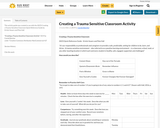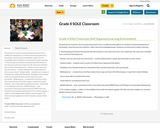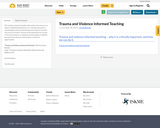
This activity guide was created to use with the ASCD Creating a Trauma-Sensitive Classroom Quick Reference Guide by Kristin Souers and Pete Hall.
- Subject:
- Psychology
- Social Studies
- Material Type:
- Teaching/Learning Strategy
- Date Added:
- 10/02/2019

This activity guide was created to use with the ASCD Creating a Trauma-Sensitive Classroom Quick Reference Guide by Kristin Souers and Pete Hall.

My goal was to transform the learning environment from a traditional atmosphere to a student-led learning experience. Essentially, I have become the facilitator, rather than the knowledge keeper. Students are immersed in inquiry learning.
1. The learning environment has become the third teacher in the classroom and is very important. My classroom is divided into a variety of learning zones:
- Teacher zone (an area near the smart board – could be defined with a carpet and invite kids to come closer)
- Student tables – students work in pods of 4 (which have replaced all the desks)
- Reading corner (leveled books line a bookshelf. Mats and bean bag chairs were purchased)
- Walking lanes – a simple line on the floor where kids can go and wear off a little energy or to get their minds thinking
- Horse shoe table for guided instruction
- Small table for an individual work area
- Bulletin Boards – have consciously tried to have them interactive (RAN Chart and Parking Lot, homemade whiteboards)
2. For student supplies, a caddy is in the middle of each table for shared supplies. All other personal supplies are stored in baskets and put in their lockers

"Download our Toolkit for Promoting Empathy in Schools. You can download the toolkit in Spanish, French, and Korean, too.
The Start Empathy Toolkit is the product of interviews with more than 60 educators and leading social entrepreneurs. We asked quite simply, “What works?” We wanted to know what it would take to create a classroom where kids’ social and emotional needs are met and how to cultivate the kinds of skills that are critical for success in today’s (and tomorrow’s) world. The result is not a prescription or a formula, or a silver-bullet fix. Consider this a living set of tools: tools that will grow and evolve over time, as each of us adds our own. We encourage you to think beyond your classroom walls to what it takes to mobilize your entire school community. Together, let’s creatively reimagine what changemaking education can look like.
The toolkit contains the combined wisdom of dozens of teachers, organizations, and people who live this everyday: tips and tools, lesson plans and examples, and, most importantly, insights that can help inform everything from how you design your classroom to your daily interactions with students and colleagues. Some exercises can be done in as little as two minutes, while others can take the form of months-long class projects, applied to a range of subjects. Others simply offer a strategy you can adapt to your existing lesson plans, and tips that are proven to improve teacher and student performance alike. Some you may be familiar with, and others may be new. We invite you to test these in your classroom, and use them to generate ideas of your own."

This website contains Canadian information and resources on Adverse Childhood Experiences
It is critically important to acknowledge, however, that interpersonal violence is not the only source of trauma. Trauma can be experienced as a result of structural violence, or experiences that happen to children because of who they are, how they live, and lack of opportunities.